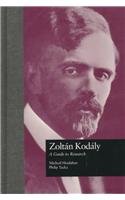 Zoltán Kodály: A Guide to Research, by Micheál Houlahan and Philip Tacka. New York: Garland Publishing, 1998. xiv + 613 pp. ISBN 0-8153-2853-2.
Zoltán Kodály: A Guide to Research, by Micheál Houlahan and Philip Tacka. New York: Garland Publishing, 1998. xiv + 613 pp. ISBN 0-8153-2853-2.
Zoltán Kodály: A Guide to Research is the first annotated bibliography to focus on the musical and educational endeavors of Zoltán Kodály as a twentieth-century Hungarian composer, ethnomusicologist, and music pedagogue. This clear and concise guide presents a complete catalogue of Kodály's compositions as well as an annotated list of writings, biographical sketches, historical studies, and library resources. A thorough and detailed resource and pedagogical tool, this volume constitutes an invaluable contribution to contemporary research, with immediate appeal for both musicologists and scholars in the area of general music education.
This work is one of four bibliographic guides published during the second half of the twentieth century and devoted to Kodály studies. The earliest publications authored by John Barron (A Selected Bibliography of the Kodály Concept of Music Education, Avondale Press, 1979) and Barbara Kaplan (The Kodály Concept: A Bibliography of Music Education, Whitewater, Wisconsin: Organization of American Kodály Educators, 1985) focus primarily on the compilation of materials relating to the composer's philosophy of music education. In Kodály's Music Concept in the International Practice (Kecskemet, Hungary: Zoltán Kodály Pedagogical Institute, 1993) Dr. Ágnes Szögi compiles basic published and unpublished materials and presents general information about his music-related endeavors and compositions. However, Zoltán Kodály: A Guide to Research represents an exciting and substantial step forward toward meeting the needs of contemporary researchers. Among the most notable and innovative aspects of this guide are the listings of Kodály's published compositions by genre, the detailed and comprehensive annotations, and the clarity of presentation and layout.
In selecting and organizing citations for the volume, the authors conducted careful research and investigation using archival material located in both Hungary and the United States. They consulted and worked with leading authorities, including Dr. László Eösze (Kodály's biographer), Professor Mihály Ittzés, Assistant Director of the Kodály Institute in Kecskemét, Hungary, and Professor Elliot Antokoletz, Professor of Music at the University of Texas, Austin, who provided expertise and a model for the work. Eminently qualified for this study, Houlahan and Tacka have written numerous articles related to the Kodály concept of education, delivered papers for national and international conferences, and are well-acquainted with Kodály scholars and with key issues and trends in Kodály studies throughout the world.
Chapter I is an informative biographical overview of the life of Zoltán Kodály. Using succinct outline form, the authors highlight the key events and accomplishments in the composer's life and place his works and educational endeavors within this framework. Information is organized and presented in four sections: "The Early years" (1882-1905), "The Young Composer" (1905-1922), "The Creative Period" (1923-1939), and "The Educator" (1940-1967). Brief introductory paragraphs focus on important issues in Kodály's life and trace the composer's developing interests in education and the growing link between his compositions and the musical education of children in Hungary.
Chapter II is a well-conceived catalogue of published compositions organized by genre. Working in consultation with László Eösze and Mihály Ittzés, Houlahan and Tacka have created a useful system of categorization, dividing the compositions conveniently into works for the stage, orchestra, chamber and instrumental works, masses, songs, accompanied choral works, unaccompanied choral works, choral collections, transcriptions, the Kodály choral method, and textbooks. The 228 listings include the year composed, year published, original and subsequent publishers, authors of texts, and languages of texts. Information may include the period of composition or its official date of completion; the person or group to whom the work is dedicated; the date, performer(s), and location of the first performance; the original cast members; voicing; instrumentation; and publisher. Movements of a work are indicated by Roman numerals, while individual pieces within a work are indicated by Arabic numerals (p. 22).
Chapters III through VII feature nearly 1500 annotated entries. The entries are organized in sections entitled "Kodály's Writings and Other Documents" (Chapter III); "Biographical and Historical Studies" (Chapter IV); "Studies of Kodály's Musical Compositions" (Chapter V); the "Kodály Concept of Music Education" (Chapter VI); "Dissertations and Theses" (Chapter VII); and "Bibliographic Guides" (Chapter VIII), which include an author and title index, a compositions index, and a proper names index. The authors state that the "intention of this volume is to make the greatest amount of information on Kodály accessible with the least amount of effort for the researcher" (p. xii), and in spite of space limitations, the authors incorporate a relatively large number of entries in each content area. Through a well-thought-out process of distillation and identification of essential information, Houlahan and Tacka succeed in meeting their goals and capturing the essence of each entry.
The superb clarity and organization of Zoltán Kodály: A Guide to Research will facilitate the task of incorporating changes and additions in future editions. Space is certainly a limiting factor in a study of this size and scope and there are invariably oversights. For example, Katinka Daniel is a significant early pioneer in the Kodály concept of music education, and it is hoped that her works will be reviewed and included in the next edition. Most importantly, as technology continues to play an increasing role in research endeavors, it may be helpful to add a chapter on technological resources such as relevant web sites.
The immense value of this publication lies in its wide range of complementary and annotated entries. As the authors state, the primary goal of the work is to "facilitate research in Kodály studies for an English-speaking audience" (p. xii). Houlahan and Tacka have certainly succeeded in accomplishing this goal and in providing a resource that is valuable for personal use as well as for undergraduate and graduate courses. This thorough and detailed guide can easily meet the needs of today's performers, educators, and scholars and is an excellent addition to every music library.


